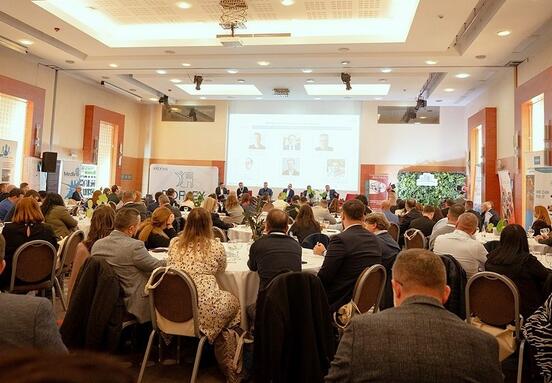Romania’s industrial and logistics space market continued to grow in 2024, with deliveries of around 400,000 square meters, bringing the total stock to 7.4 million square meters, according to Colliers’ annual report. Representatives of the real estate consultancy say that the current stock of industrial and logistics spaces, estimated at 8 million square meters by the end of 2025, remains modest compared to countries such as Poland, which has a volume four times larger.
“Romania’s industrial and logistics space market continued to grow in 2024, with deliveries of around 400,000 square meters, bringing the total stock to 7.4 million square meters,” according to Colliers’ annual report.
International and local investor interest has increased, and major transactions, such as the expansion of retailers LPP and Deichmann, confirm Romania’s position as a strategic distribution hub for Southeastern Europe. In the long term, the market remains attractive due to the competitiveness of the workforce and the modernization of infrastructure, but in the short term, economic and political uncertainties could slow the pace of expansion.
The year 2024 ended with leases for approximately 620,000 square meters, down by about 20% compared to the near-record level reached in 2023, according to preliminary estimates. However, this result does not fully reflect the dynamics of the local market, Colliers consultants emphasize, given that only public transactions are included – either reported by local research offices, publicly announced by companies or in the investor reports of listed companies. In reality, a significant part of the leasing activity, especially contract renewals and other unreported direct transactions, could represent at least 20-30% of the total volume.
“If before the pandemic the annual leasing volume was below 500,000 square meters, the 2024 result confirms a growing market. Although CTP and WDP remain leaders, controlling two-thirds of the total stock, we see an intensification of activity from other developers as well. The entry into the market of renowned developers Garbe (Germany) and Hillwood (US), together with increasing investments from local players, indicates a positive dynamic and solid growth prospects. In addition, for the second consecutive year, a third of the leased spaces were intended for production, compared to only 10-15% in previous years, which reflects major investments in the industrial sector. However, many manufacturing companies prefer to own the spaces in which they operate, a trend that influences the market structure in the long term”, explains Victor Coşconel, partner | head of Leasing | Office & Industrial Agencies at Colliers.
More than half of the industrial and logistics space leases were made in Bucharest and the adjacent areas, but this percentage is significantly lower than the average of the last decade; which highlights the accelerated development of regional centers, which are becoming increasingly attractive for industrial and logistics operations. Although Bucharest remains the main destination for this sector, Colliers consultants estimate that, in the long term, its share will decrease, as other cities in the country attract more and more investors and logistics operators.
The vacancy rate remains low, around 5% at national level, which limits the negotiation options for tenants, especially in the context of a small number of speculative developments. Rents have stabilized, with a Built-to-Suit (BTS) warehouse in a premium area renting for 4.5-5 euros per square meter in Bucharest and the main cities.
In comparison, before 2021, rents were below 4 euros per square meter, reflecting a significant market adjustment.
The largest transaction of the year was the expansion of fashion retailer LPP, which leased 42,000 square meters of warehouse space in northern Bucharest, reaching a total of over 130,000 square meters, thus becoming one of the largest tenants in Romania. Footwear retailer Deichmann also pre-leased a 20,000 square meter warehouse in Bucharest, which it will transform into a regional distribution center. Meanwhile, Federal Mogul, a car parts manufacturer, has signed a sale & leaseback agreement with WDP for its 19,000 square meter factory in Ploiesti.
Also, a major FMCG distribution network on the Romanian market inaugurated its first temporary warehouse, which includes 10,000 square meters in MLP Bucharest West. And GXO completed the first phase of its project at the end of the year, intended for the retailer Trendyol, aiming for an area of 50,000 square meters. Both transactions were brokered by the Colliers team.
“These transactions show the dynamics of the local market and current trends, consolidating the role of Romania as a regional distribution hub for South-Eastern Europe and, in some cases, for the whole of Central and Eastern Europe. With the rapid improvement of infrastructure and full accession to the Schengen area in 2025, Romania is becoming increasingly attractive for logistics investments. One of the main advantages is the low labor cost compared to productivity, the best in the European Union in areas such as transport and warehousing. Even after the wage increases of the last decade, Romania remains competitive at European and global level, attracting more and more companies interested in expanding their presence in the region”, states Coşconel.
Infrastructure modernization is another key advantage in economic growth and the development of the industrial and logistics sector. After a record year in 2024, with 1,200 kilometers of expressways delivered, Romania could reach 2,000 kilometers by the end of the decade. Currently, over 600 kilometers of motorways and expressways are under construction, and another 700 kilometers are in preparation. The completion of key sections, such as Sibiu-Piteşti and Iaşi-Târgu Mureş, will improve connectivity and attract new investments.
“Romania has significant long-term potential due to its competitive workforce, strategic location and infrastructure investments. However, the current stock of industrial and logistics spaces, estimated at 8 million square meters by the end of 2025, remains modest compared to countries such as Poland, which has a volume four times larger. An increase to 11-12 million square meters by the end of the decade is a realistic objective. In the short term, however, economic and political uncertainties may influence the pace of expansion, but large-scale transactions could bring positive surprises and support market activity,” he concludes.








